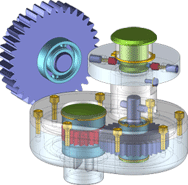
When displaying 3-D parts,HiCAD distinguishes between the edge model and the surface model.
Edge model
Here, the edges of the part are displayed, which conforms to the standards
of technical drawing. Edges can be hidden or visibly highlighted by means
of various settings, in order to facilitate construction. This concerns,
for example, hidden edges (automatic hidden line algorithm), highlighted
edges (edges that form the outline of a part), lateral edges, tangential
transitions etc.
Surface model
The surface model displays the surfaces of the constructed parts in colour
to support the spatial view during construction. The display depends on the colouring and lighting.
In reality, the optical impression of an object is determined by a large
number of characteristics which can scarcely be captured even in complex
calculations (the Gamma Ray tool does this by way of approximation).
A number of assumptions which both simplify handling and speed up calculation
are therefore made with regard to the shading method, also called rendering.
Surface colour
The colour of a surface is a property of the surface alone, i.e. light
is assumed to be "colourless". Depending on the graphic output,
only a limited number of different colours, referred to as a colour table,
is available. The colour is assigned to the surface as a number, and its
mixture of the basic colours of red, green and blue can be varied.
Brightness
The brightness of a surface depends on the lighting and its surface
properties. The following models are provided for the lighting:
The surface is assumed to be flat, i.e. curved surfaces are approximated internally by means of a sequence of flat surfaces. The optical attributes (absorption, reflection etc.) are assumed to be the same for all surfaces and expressed by means of the so-called lighting parameters. Brightness is therefore composed of three contributions.
Transparency
If a part is created as transparent (layer=40), its surfaces are only
filled "incompletely", with the result that surfaces below shine
through.
Shading type
To speed up brightness calculations, various shading types are made
available:

Representation of Views (3-D) • View Functions (3-D) • Material and Lighting (3-D)
|
© Copyright 1994-2018, ISD Software und Systeme GmbH |